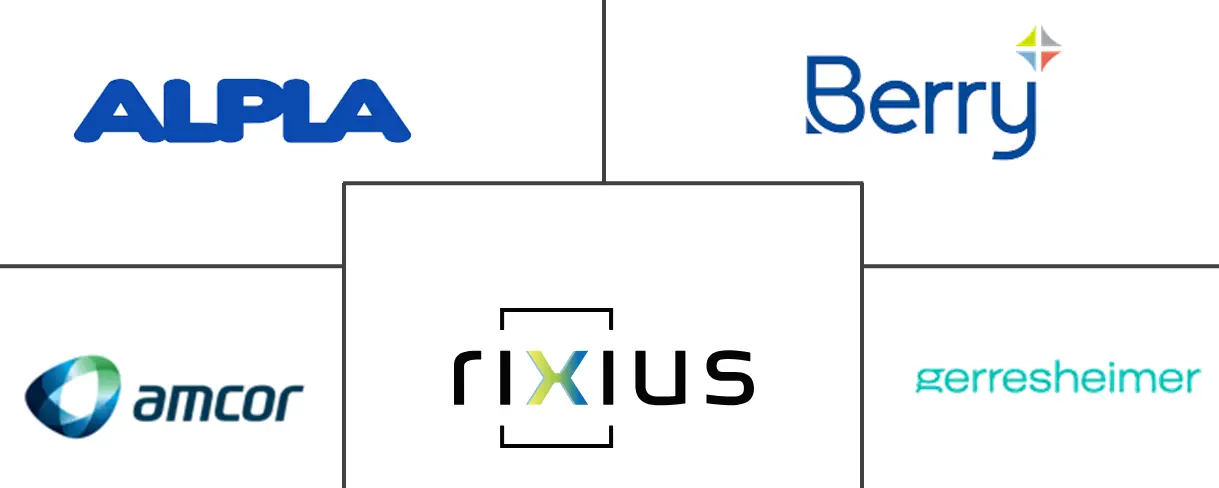Germany Plastic Bottles Market Size and Share
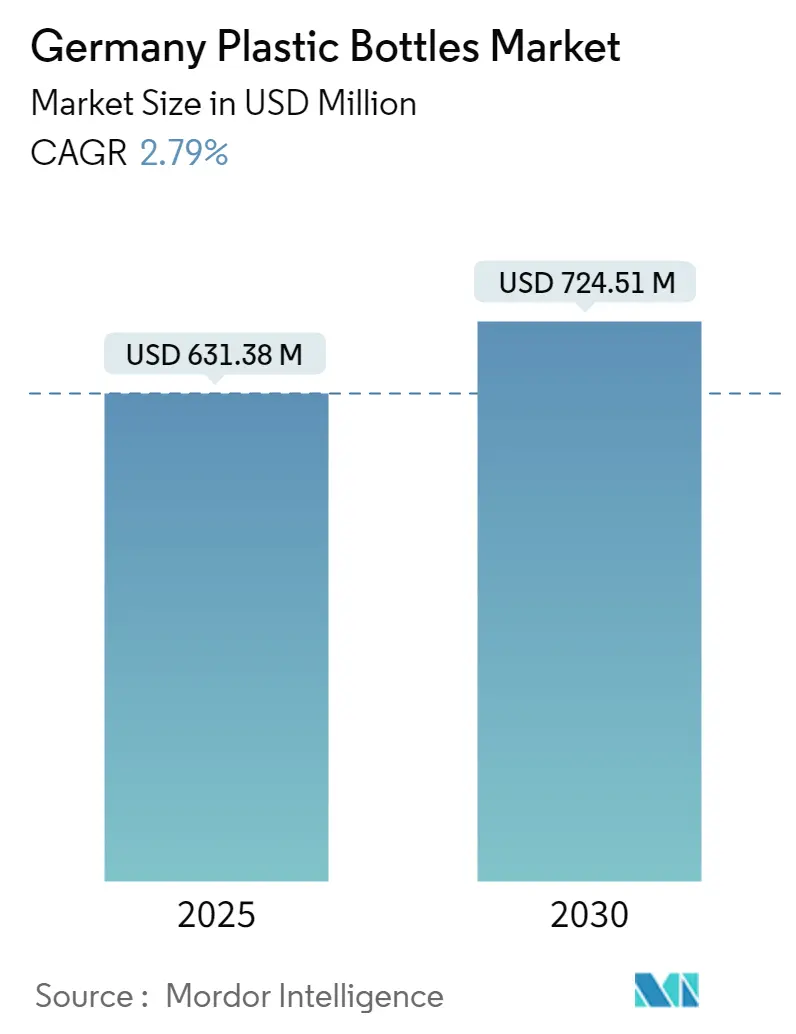
Germany Plastic Bottles Market Analysis by Mordor Intelligence
The Germany Plastic Bottles Market size is worth USD 631.38 Million in 2025, growing at an 2.79% CAGR and is forecast to hit USD 724.51 Million by 2030.
- The plastic bottles market in Germany plays a pivotal role in the country's packaging industry, fueled by demand from industries like beverages, cosmetics, pharmaceuticals, and household products. Valued for their lightweight nature, durability, and versatility, plastic bottles are the go-to choice for diverse applications. The market showcases a variety of plastic materials, including polyethylene terephthalate (PET), high-density polyethylene (HDPE), and polypropylene (PP), each tailored to meet distinct end-user needs.
- PET reigns supreme as the preferred plastic for beverage bottles in Germany, owing to its beneficial features like clarity, strength, and recyclability. Dominating the soft drinks and bottled water segments, PET bottle manufacturers are on a continuous quest for sustainability. Innovations like "lightweighting," trimming bottle weight without sacrificing quality, are pivotal in curbing material usage and transportation emissions. Furthermore, the rising trend of incorporating recycled PET (rPET) is largely fueled by consumer demand and regulatory pushes for better environmental practices.
- High-density polyethylene (HDPE) finds its niche in the German plastic bottle market, predominantly packaging household and personal care items, especially cosmetics. With superior moisture barrier properties and chemical resistance, HDPE bottles cater to a broad spectrum of products. The cosmetics industry emphasizes eye-catching designs without compromising product integrity, spurring innovations like bio-based HDPE from renewable sources and echoing the industry's tilt toward sustainable packaging.
- Germany's pharmaceutical industry leans heavily on plastic bottles, favoring HDPE and PP for their durability and contamination protection. Due to the strict regulations in pharmaceutical packaging, there is a constant drive for innovation to uphold safety and compliance. Features like tamper-evident and child-resistant closures, alongside enhanced barrier properties, are vital to meet the industry's high standards.
- Innovation in Germany's plastic bottle market is not just about materials but also about refining production processes and design. Advanced techniques like blow molding and injection molding are revolutionizing production, allowing for intricate shapes and designs that resonate with consumer preferences and bolster brand distinction.
- In addition to this, Germany's plastic bottle market is pivoting toward sustainability, spurred by consumer consciousness and regulatory mandates. The European Union's push to cut down plastic waste and ramp up recycling is urging manufacturers to explore and invest in eco-friendly avenues. Starting January 1, 2024, Germany introduced a deposit of at least EUR 0.25 (USD 0.28) on plastic bottles for milk products. This change impacts regular milk, beverages with over 50% milk content, and other drinkable items like cocoa, coffee drinks, kefir, and yogurt. Since 2022, nearly all single-use plastic beverage bottles and cans in Germany have been subject to a mandatory deposit.
Germany Plastic Bottles Market Trends and Insights
Growing Demand from the Food and Beverage Industries
- Plastic bottles are integral to Germany's vast food and beverage landscape, especially for carbonated and non-carbonated soft drinks, juices, and energy drinks. As one of Europe's leading markets for these products, Germany boasts a discerning consumer base that values both convenience and quality packaging. The beverage industry's preference for plastic bottles stems from their lightweight nature, durability, and cost-effectiveness, appealing to both manufacturers and consumers. With a growing emphasis on convenient and portable beverage options, the demand for plastic bottles remains strong.
- Juices and energy drinks leverage the versatility of plastic packaging, offering diverse bottle designs and sizes to meet varied consumer tastes. Innovations in bottle design and materials, particularly with a focus on sustainability, have emerged in the German market. In response to environmental concerns and regulatory pressures, there is a rising trend toward recyclable and biodegradable plastics. These innovations not only cater to the aesthetic and functional preferences of consumers but also align with the global push toward reducing plastic waste and promoting a circular economy.
- Plastic bottles extend beyond beverages, playing a pivotal role in food applications like packaging sauces, mayonnaise, and soy sauce. These items demand packaging that preserves freshness and integrity while being user-friendly. Plastic bottles meet these needs with features like resealable caps and ergonomic designs. The rising demand for plastic bottles in food applications mirrors the increasing preference for ready-to-use condiments and sauces, highlighting shifts in consumer lifestyles. This trend is further supported by the busy schedules of modern consumers who seek convenience without compromising on quality.
- Environmental considerations are reshaping the German plastic bottles market. As consumers grow more environmentally conscious, the demand for sustainable packaging solutions intensifies. Manufacturers are pivoting toward eco-friendly alternatives, such as biodegradable plastics and recycled materials, not just to meet consumer expectations but also to adhere to strict environmental regulations. The industry's shift toward a circular economy is evident, with a pronounced focus on recycling initiatives and minimizing plastic waste. Companies are investing in advanced recycling technologies and collaborating with environmental organizations to enhance the sustainability of their packaging solutions.
- According to the Non-Alcoholic Beverages Industry Association (WAFG), in 2023, the average German consumed about 33.8 liters of cola and cola-based drinks, leading the soft drink consumption chart. This high soft drink consumption, especially among the youth, underscores the burgeoning demand for plastic bottles in the country. The popularity of these beverages among younger demographics highlights the importance of targeting this segment with innovative and sustainable packaging solutions to maintain market growth.
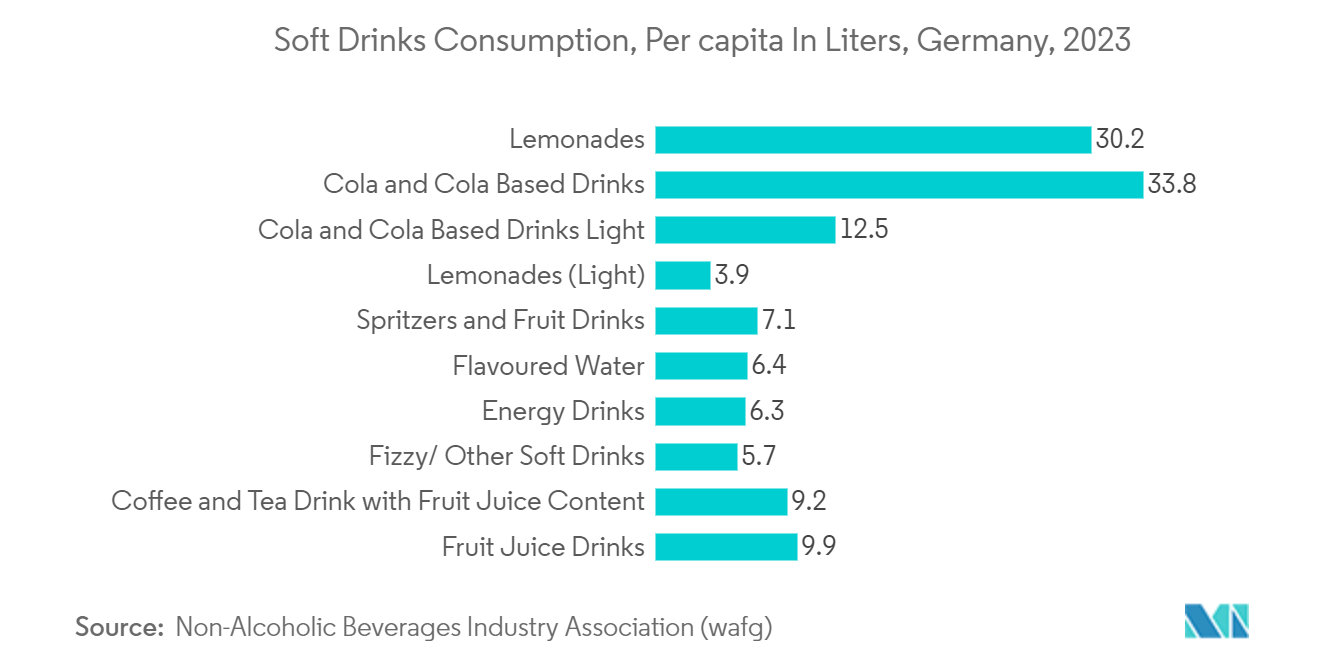
Inclination of Personal Care Brands Toward Sustainability Drive Innovations
- Germany, being Europe's largest cosmetics market, offers a significant arena for plastic packaging, especially bottles. These bottles cater to a diverse range of products, spanning skincare, haircare, perfumes, and toiletries. The demand for plastic bottles in these industries is fueled by convenience, cost-effectiveness, and the capacity to craft visually appealing packaging that bolsters brand identity and attracts consumers. The German market's robust infrastructure and advanced manufacturing capabilities further support the growth and innovation in plastic bottle packaging.
- Plastic bottles are favored in the cosmetics industry for their versatility and lightweight nature. They facilitate creative designs, helping products stand out on crowded retail shelves. Plastic bottles provide practical solutions for items like shampoos, conditioners, lotions, and creams, offering various dispensing options such as pumps, sprays, and squeezable designs. The cosmetics market's shift toward premiumization has spurred the creation of sophisticated, aesthetically pleasing plastic packaging, often featuring advanced printing and finishing techniques to exude luxury and quality. Additionally, the ability to customize plastic bottles with unique shapes, colors, and textures allows brands to differentiate their products and enhance consumer engagement.
- The toiletry and perfumery segments also have a strong reliance on plastic bottles. For instance, perfume bottles demand precise designs to ensure effective fragrance preservation and dispensing. Moreover, plastic's inherent flexibility enables the crafting of ergonomic designs that enhance user experience. The use of plastic in these segments also allows for innovative features such as UV protection and airless dispensing systems, which help maintain the quality and longevity of the products.
- In Germany, the plastic bottle market trends are increasingly swayed by sustainability and environmental concerns. As consumers grow more eco-conscious, companies are pivoting toward greener practices and materials. There is a rising appetite for recyclable and biodegradable plastics alongside initiatives aimed at curbing plastic waste. Brands are channeling investments into packaging innovations that resonate with circular economy principles, such as utilizing post-consumer recycled plastics and designing bottles for easier recycling. Furthermore, regulatory pressures and industry standards are pushing manufacturers to adopt more sustainable practices, which is driving the development of new materials and technologies in plastic packaging.
- As per IKW, the German Cosmetic, Toiletry, Perfumery and Detergent Association, in 2023, drugstores accounted for approximately 51% of all sales, highlighting the sales distribution for cosmetics and body care products in Germany. This statistic underscores the robust demand for personal care plastic bottles. The prominence of drugstores as a sales channel reflects consumer preferences for convenience and accessibility, making them a critical distribution point for personal care products. This trend is likely to continue, further boosting the demand for innovative and sustainable plastic bottle solutions in the German market.
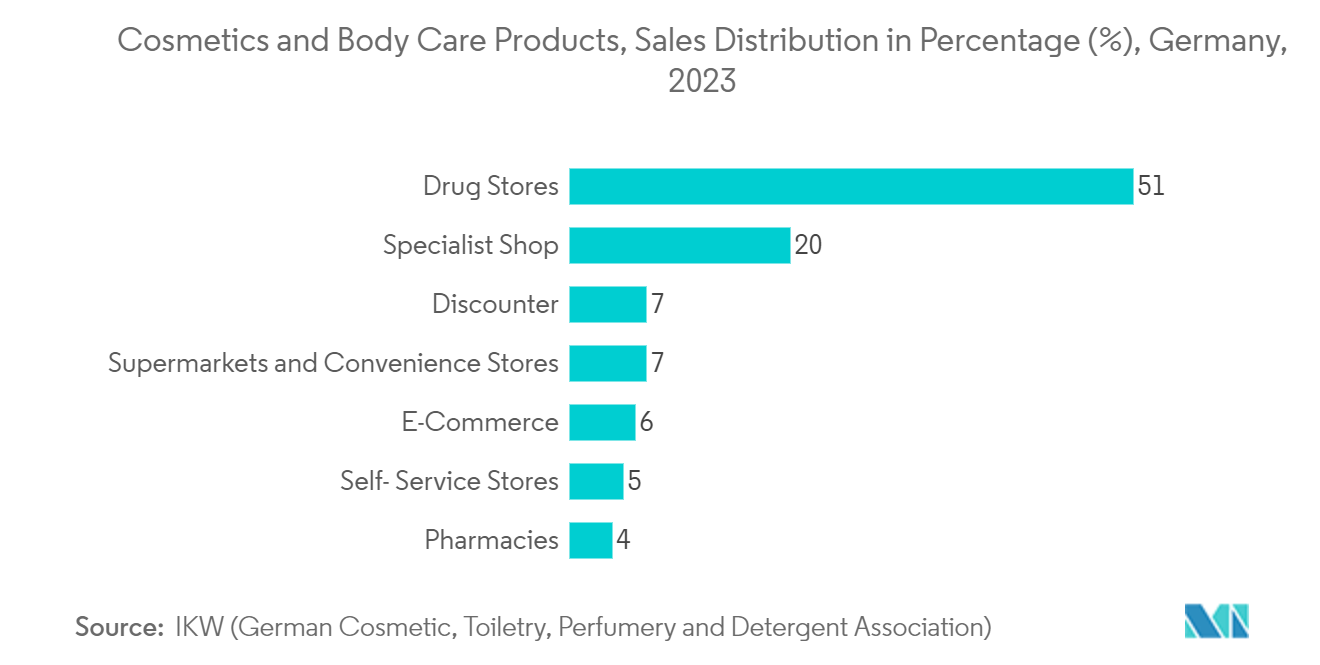
Competitive Landscape
The German plastic bottles market is fragmented due to the presence of several market players. Some major players in the market include Amcor Group GmbH, Alpla Group, Berry Global Inc., Gerresheimer Inc., and Berlin Packaging GmbH. The players are leveraging the opportunities posed by the growth of several end-user verticals and innovating to expand their market presence.
- November 2023 - German water bottle company Air Up teamed up with specialty materials firm Eastman to launch its fresh line of reusable bottles. Targeting the European market, this new range utilizes Eastman’s Tritan Renew material, boasting 50% certified recycled content, thanks to Eastman’s advanced molecular recycling technology. This innovative process deconstructs hard-to-recycle plastics into their fundamental molecular components, enabling their repurposing into new polymers. The collaboration birthed Air Up’s generation 2 bottles, now featuring Tritan Renew, and they come in two convenient sizes, i.e., 600 ml and 1 L.
- October 2023 - Alpla, a packaging specialist, teamed with Privatbrunnen Tönissteiner, a German mineral water company, to create a reusable PET bottle crafted entirely from recycled materials. After a year of collaborative development, the new bottle not only boasts a one-litre size but is also fully recyclable at the end of its life. These innovative bottles have already made their debut at retail outlets across Germany.
Germany Plastic Bottles Industry Leaders
-
Amcor Group Gmbh
-
Berry Global Inc.
-
Alpla Group
-
Gerresheimer AG
-
Rixius AG
- *Disclaimer: Major Players sorted in no particular order
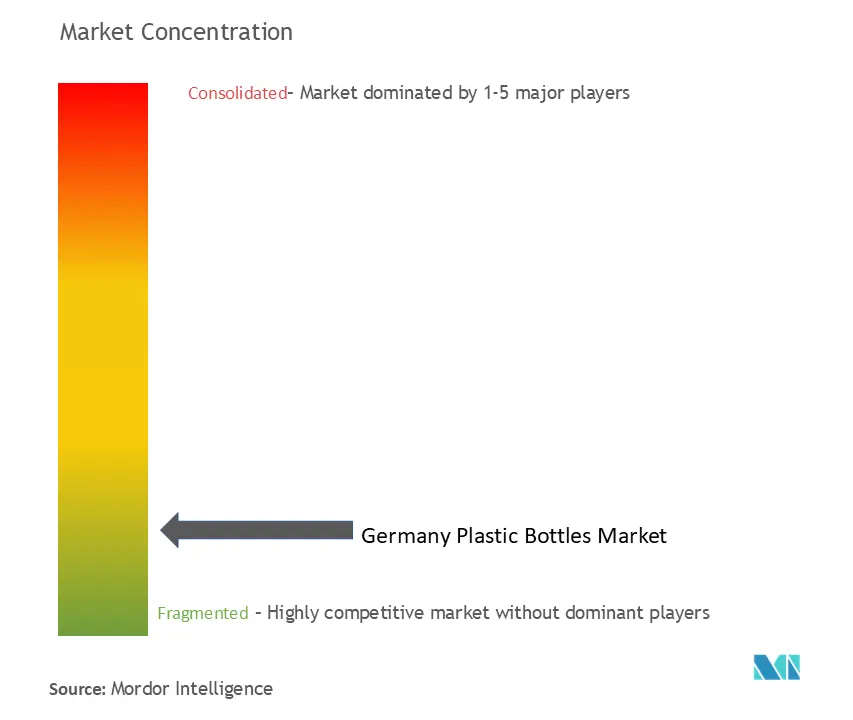
Recent Industry Developments
- October 2023: Germany joined the ranks of countries like Spain and the United Kingdom by introducing its own 'plastics tax.' In May 2023, Germany passed the Single-use Plastics Fund Act, which integrates Articles 8, 1-7 of the Single-use Plastics Directive into German law. This act established the legal foundation for the Federal Environment Agency (UBA) to implement the single-use plastic fund.
- January 2023: Revalyu Resources GmbH, headquartered in Kleinostheim, Germany, unveiled plans to invest USD 50 million as part of its strategic expansion into the United States. The company is set to construct a plant in Statesboro, Georgia. According to the company, once the initial phase of construction wraps up, the plant will boast the capacity to process over 225,000 pounds per day of polyethylene terephthalate, commonly known as polyester, converting it into PET polymers and recycled PET (rPET) flakes.
Germany Plastic Bottles Market Report Scope
The scope of the study characterizes the plastic bottles market based on the raw materials of the product, such as PP, PE, PET, and other raw materials, used across various end-user industries such as food, pharmaceuticals, beverages, cosmetics, and toiletries. The research also examines underlying growth influencers and significant industry vendors, all of which help to support market estimates and growth rates throughout the anticipated period. The market estimates and projections are based on the base year factors and arrived at top-down and bottom-up approaches.
The German plastic bottles market is segmented by resin (polyethylene (PE), polyethylene terephthalate (PET), polypropylene (PP), and other resins) and end-use industries (food, beverage [bottled water, carbonated soft drinks, alcoholic beverages, juices and energy drinks and other beverages (powdered and dairy-based beverages)], pharmaceuticals, personal care and toiletries, household chemicals, paints and coatings, and other end-use industries). The market sizes and forecasts are provided in terms of value (USD) and volume (tonnes) for all the above segments.
| Polyethylene (PE) |
| Polyethylene Terephthalate (PET) |
| Polypropylene (PP) |
| Other Resin type (Polystyrene, PVC, Polycarbonate, etc.) |
| Food | |
| Beverage | Bottled Water |
| Carbonated Soft Drinks | |
| Alcoholic Beverages | |
| Juices and Energy Drinks | |
| Other Beverage | |
| Pharmaceuticals | |
| Personal Care and Toiletries | |
| Industrial | |
| Household Chemicals | |
| Paints and Coatings | |
| Other End-use Industries |
| By Resin | Polyethylene (PE) | |
| Polyethylene Terephthalate (PET) | ||
| Polypropylene (PP) | ||
| Other Resin type (Polystyrene, PVC, Polycarbonate, etc.) | ||
| By End-use Industries | Food | |
| Beverage | Bottled Water | |
| Carbonated Soft Drinks | ||
| Alcoholic Beverages | ||
| Juices and Energy Drinks | ||
| Other Beverage | ||
| Pharmaceuticals | ||
| Personal Care and Toiletries | ||
| Industrial | ||
| Household Chemicals | ||
| Paints and Coatings | ||
| Other End-use Industries | ||
Key Questions Answered in the Report
How big is the Germany Plastic Bottles Market?
The Germany Plastic Bottles Market size is worth USD 631.38 million in 2025, growing at an 2.79% CAGR and is forecast to hit USD 724.51 million by 2030.
What is the current Germany Plastic Bottles Market size?
In 2025, the Germany Plastic Bottles Market size is expected to reach USD 631.38 million.
Who are the key players in Germany Plastic Bottles Market?
Amcor Group Gmbh, Berry Global Inc., Alpla Group, Gerresheimer AG and Rixius AG are the major companies operating in the Germany Plastic Bottles Market.
What years does this Germany Plastic Bottles Market cover, and what was the market size in 2024?
In 2024, the Germany Plastic Bottles Market size was estimated at USD 613.76 million. The report covers the Germany Plastic Bottles Market historical market size for years: 2019, 2020, 2021, 2022, 2023 and 2024. The report also forecasts the Germany Plastic Bottles Market size for years: 2025, 2026, 2027, 2028, 2029 and 2030.
Page last updated on:
Germany Plastic Bottles Market Report
Statistics for the 2025 Germany Plastic Bottles market share, size and revenue growth rate, created by Mordor Intelligence™ Industry Reports. Germany Plastic Bottles analysis includes a market forecast outlook for 2025 to 2030 and historical overview. Get a sample of this industry analysis as a free report PDF download.
